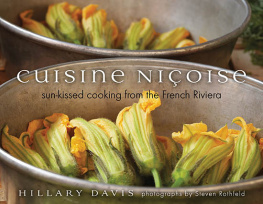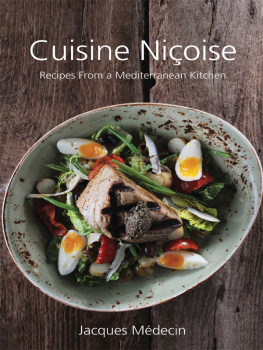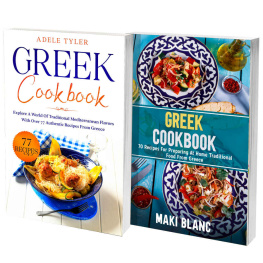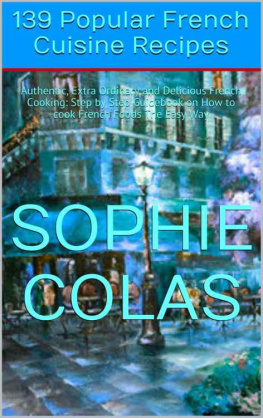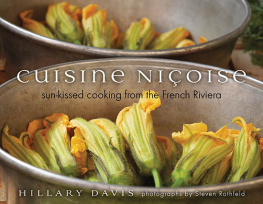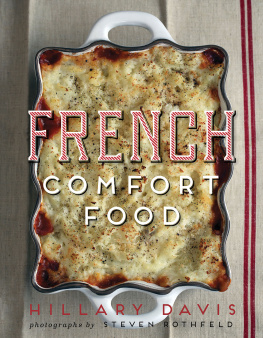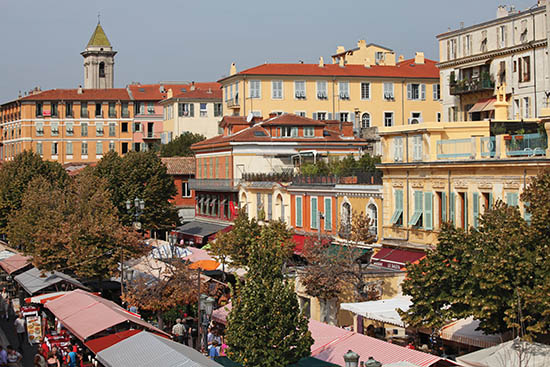Introduction
Why had I never heard of cuisine Nioise?
Why had I never heard of socca , or la trouchia,tout-nus or tourte de blettes ?
By the time I moved to France, to the village of Bar-sur-Loup in the nearby hills behind Nice, I had spent years cooking my way through dozens and dozens of French cookbooks, learning the styles of cooking from Normandy, Alsace, Provence, the Basque country, Bordeaux and Lyon. I had lived in Paris. I had vacationed every year in France. I had eaten my way through the French Michelin stars. Yet I had never come across the term cuisine Nioise.
It wasnt until I moved to my village, dined with neighbors, and took food-shopping excursions to Nice that it became clear I had missed something very big. I discovered a way of cooking that was so much more than Salade Nioise. It was not only a cuisine but also a way of life defined by the sea, the garden, the sun, and the proximity of this corner of France to Italy.
My wonder at finding something so intriguing soon grew into a quest to learn this unsung cuisine, to see if it was worth singing. It all began when we decided to move to the South of France and started looking for a village to call home. I will never forget seeing it for the first time. At a turn in the road, a medieval honey-colored stone village with a chateau appeared at the very top of a hill, high above the surrounding countryside. A sign indicated it was the village of Bar-sur-Loup. We drove up the winding, steep road and got out to walk.
I was home. I could feel it. It was that simple.
This was where I would eventually learn to cook cuisine Nioise. This was where I would learn to forage, till a garden, harvest olives, buy fresh every day from the local farmers and in the open-air markets, spend my Sundays cooking and sharing meals with friends, and buy locally made pottery to serve it on and locally made wine to serve with it.
Bar-sur-Loup
Bar-sur-Loup is in the pays Niois , that area around Nice where they cook in the style of Nice. The area extends from Grasse, all the way across to Sospel, and from Cannes to Nice and over to Menton. The coastal portion is the Cte dAzur.
Bar-sur-Loup, a small, perched town with cobblestone alleys, an ancient parish church and panoramic views, is known as the city of oranges. It holds an annual orange festival, the Fte de lOranger , because the orange tree loves our village. The bigarade , or bitter orange, grows with abandon all over the wide, grassy terraces cut into the steep hills that climb up to the village. As the day warms, they bask in the Mediterranean sun, perfuming the air.
Rosemary grows like a weed all over the countryside. So do tangles of uncultivated roses, fertile fig trees, olive trees, rambling grape vines, and fragrant mimosa trees hanging heavy with bright yellow flowers. Wild lavender and thyme cover the scrubby hills; wild mushrooms sprout in the forests in the fall; and tiny violets intermingle with new grass and wildflowers in the open fields. Herbs blossom madly along paths, at the sides of mountain roads, and in the crooks and crannies of ancient stone walls.

Fruit trees, including bigarade orange, lemon, cherry, olive, and fig, surrounded the house we bought just below the village. Set on four acres, with ancient terraces holding gnarly vines, stone fences, and untamed bushes, the house had a breathtaking view of the dramatic limestone cliffs of the Gorges du Loup, the waterfall cascading down into the canyon of the Gorges, and the even more highly perched village of Gourdon, which in the black night sky seemed to hover like a well-lit flying saucer above our village.
I learned over time that the orange trees around my house bore the fruit that I bought candied in the open-air markets; that their blossoms would go into making the fragrances being produced a few miles away in Grasse, where they extracted essential oil from the flowers and called it neroli; that the dried peel is used in bouquet garni; and that its oil is used to flavor Frances most famous orange liqueurs, Cointreau and Grand Marnier. A new friend in the next village also informed me one day that the bigarade orange provides the top notes for Miss Dior Cherie perfume!
Those orange trees, that house, the village, and the wild boar that were frequently herded down the road just outside my gate colored my life and changed it forever.
Cuisine Nioise
Cuisine Nioise is the style of cooking found in Nice, in the countryside around Nice, and for the most part in our village. It comes from humble origins, with most of the recipes having been inherited from grandmothers who prepared farmhouse cuisine from produce grown in their kitchen gardens using recipes that were handed down for generations and often served to three of them sitting at the kitchen table for Sunday dinner.
Many of those grandmothers were either Italian or French influenced by Italian cuisine, because the entire area along the coast from Cannes towards Monaco had been part of Italy until 1860, when it was ceded to France. So the cuisines of those two countries are entwined and intermingled in the most ideal culinary match of Italian and French traditions. The resulting cuisine Nioise springs from that marriage with a strong dash of its own unique dishes not found anywhere else in France.
This area of France fits snugly close to Genoa, so subtle changes were made to typically Italian dishes on a daily basis, thereby creating the evolution of a new blend of French and Italian cooking. French Nioise cooks make gnocchi, but they fold in chopped Swiss chard; they make ravioli but stuff it with orange-scented beef stew or fry it. A favorite meal of pizza at a restaurant for lunch might be followed by a stew at home for dinner, made with an inexpensive cut of meat that has been marinated overnight in wine. The meat is enhanced with vegetables from the garden at the back of the house and herbs harvested wild from the side of the road during an afternoon walk. The daube , or French stew, is most likely served with homemade Italian tagliatelle.
Cuisine Nioise is as unique a way of cooking as that of Lyon or Alsace; however, you can find the cooking of Lyon and Alsace in restaurants throughout France, whereas much of cuisine Nioise is found only in the region around Nice. It would be hard to find

